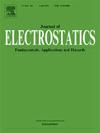关于电喷涂的最小和最大流量:基于基本原理的实用方法,用于设计目的
IF 1.9
4区 工程技术
Q3 ENGINEERING, ELECTRICAL & ELECTRONIC
引用次数: 0
摘要
最小和最大流速(Qmin,Qmax)限制了电喷射(锥形喷射模式)的操作窗口。文献并没有给出一个通用的、经过实验验证的、可用的公式。我们用基础物理学和曲线拟合推导了低/中高粘度牛顿液体的Qmin和Qo(=εoγρK)之间的关系。该公式得到了自己的实验和文献数据的证实。根据公式Qmin,可以通过仅测量待喷射液体的某些性质来获得。Qmax,很难解决。经验结果和实验数据表明Qmax/Qmin的比率在几十到几百之间。本文章由计算机程序翻译,如有差异,请以英文原文为准。
On the minimum and maximum flowrate of electrospraying: A practical approach, based on fundamentals, for design purposes
The minimum and maximum flow rates (Qmin, Qmax) limit the operational window of electrospraying (cone-jet mode). Literature does not give a general, experimentally proven, useable formula. We derived with fundamental physics and curve fitting a relation between Qmin and Qo , for Newtonian liquids with low/moderately high viscosities. The formula is corroborated by own experiments and data from literature. With the formula Qmin can be obtained by only measuring some properties of the liquid to be sprayed. Qmax, is difficult to address. An empirical result and experimental data indicate a ratio of Qmax/Qmin between some tens and some hundreds.
求助全文
通过发布文献求助,成功后即可免费获取论文全文。
去求助
来源期刊

Journal of Electrostatics
工程技术-工程:电子与电气
CiteScore
4.00
自引率
11.10%
发文量
81
审稿时长
49 days
期刊介绍:
The Journal of Electrostatics is the leading forum for publishing research findings that advance knowledge in the field of electrostatics. We invite submissions in the following areas:
Electrostatic charge separation processes.
Electrostatic manipulation of particles, droplets, and biological cells.
Electrostatically driven or controlled fluid flow.
Electrostatics in the gas phase.
 求助内容:
求助内容: 应助结果提醒方式:
应助结果提醒方式:


